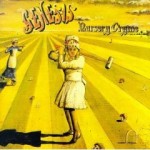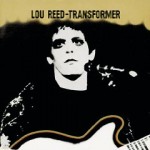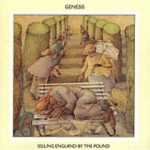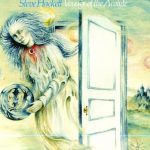In prog-rock circles, guitarist Steve Hackett is revered for his time in Genesis from the 1971 album Nursery Cryme to 1976’s Wind & Wuthering. His tenure included the recordings of classic Genesis songs like “The Musical Box”, “Dancing with the Moonlit Knight”, “Firth of Fifth”, and “The Lamb Lies Down on Broadway”. During this period he also innovated the two-handed tapping guitar technique, which was widely used Eddie Van Halen and other guitar shredders in the ’80’s and beyond. Hackett has also recorded several dozen solo albums, from 1975’s Voyage of the Acolyte to last year’s The Night Siren, and was one of the guitar heroes, along with Steve Howe, in the short-lived band GTR.
This interview was for a preview article for noozhawk.com for Steve Hackett’s concert at the Fremont Theater in San Luis Obispo on 2/23/18. It was done by phone on 2/8/18.
Jeff Moehlis: What can people look forward to at your upcoming show?
Steve Hackett: We do a mixture of things. There are at least three bands that I’ve been involved with. Well, there have been various incarnations of my own band, of course. There’s no such thing as a solo album. It’s always teams that do this stuff. But then, as regards bona fide bands, it’s Genesis and it’s GTR. Most of the set will be divided into solo stuff and Genesis, but somewhere along the line we will do the one and only hit single by GTR, which is “When the Heart Rules the Mind”. We play that as well. I started doing that live again just on Cruise to the Edge, and it went down well twice.
I have a new bass player. I’ve got Jonas Reingold from Sweden – the second Swede who plays now with this band line-up, with Nad Sylvan [on vocals]. Jonas is tremendous. This guy plays Bach on the bass to warm up. He’s a phenomenal player, a thing of a legend in certain circles.
JM: It’s cool that you’re doing a mix of things. I do remember that GTR song, so I’m looking forward to hearing that.

You joined Genesis for the Nursery Cryme album. Looking back, what are your reflections on that album?
SH: Well, Genesis was the first band that was doing exactly what I wanted to do. It had been a long time waiting in the wings, the years after school, the other jobs. Then we were just at the point where I joined them for six months, and I’d been working on them like Chinese water torture to try to get a mellotron. Some pals in King Crimson called up and said they had one that they were trying to get rid of. We ended up buying that, so that’s the history of that. Tony Banks had a Hammond organ, he liked playing piano, but I eventually talked everyone into getting a mellotron. And that’s the reason for the sound of tracks like “The Fountain of Salmacis”, the last track on that album. Funnily enough, I’m playing that one again live. That’s Roine Stolt’s favorite as well, from the Flower Kings, who was playing with us about a year ago.
Yeah, it was an interesting album, wasn’t it? It was the first time I was working with a band, as I said. Really, a lot of things were coming to pass that I’d dreamt about for a very long time. It was really the first professional band that I was working with, the first fully professional, although I’d done an album with Quiet World before that to gain some recording experience. This was the first time I was out there doing gigs, and doing gigs regularly. The first thing we did was a sell-out tour, because ticket prices were kept extraordinarily low, and we were touring with the rest of the Charisma label. So, for the price of a sandwich you could go and see three bands. So we sold out in town halls throughout England and Scotland, all about that same year of Nursery Cryme.
You had the Victoriana of “The Musical Box”. There was the aspect of the nursery and the sexuality that’s implied in that. And you had another kind of strange sexuality, the hermaphrodite aspect of “The Fountain of Salmacis”. I think a lot of these sexy songs at the time were told through allegory. It was never straightahead. It was never like the Stones. It was never “Stray Cat Blues”. It was never that. But it doesn’t mean that Genesis didn’t have that within it. It was much more subtle, I think.
JM: Yeah, you weren’t singing “I can’t get no satisfaction”, or anything like that.
SH: No, it wasn’t that. It wasn’t that, or “I ain’t never did no wrong”. It wasn’t that. No, at times there were literary references. I think if there was anything sexy there at all it was just part of one of many stories with Genesis.
So Nursery Cryme, yes, stories about strange plants like “The Return of the Giant Hogweed”, that we did as a kind of a spoof of a horror film. That was the idea. Pete [Gabriel] had the idea of the hogweed, and I said, “Why don’t we call it ‘The Return of’?” We had the Hogweed Youth Movement and all that for a while, with T-shirts made up and all this kind of stuff. Yeah, a lot of very obscure stuff, deliberately obscure. I think as obscurantist in its own way lyrically as Hermann Hesse was as an author. But that’s OK. We were allowed to do that. We were encouraged to be as original as possible.
JM: You were the new guy in the band, with Phil [Collins] starting just a touch before you. Tony [Banks], Michael [Rutherford], and Peter had known each other forever. Was is difficult to be the new guy, or did you feel that you were welcomed into the band?
SH: Yeah, I was the new guy. It was very odd. Sometimes fights would break out, and it might be over some issue to do with something that someone had done at school. You know, someone had stolen someone’s textbook, or something. Some of the issues went quite deep. But it was very creative on one level, and juvenile on another – very strange, that kind of contradiction that was implicit at the heart of the very competitive band that was Genesis. Growing up at school together, they were formed at school from two separate bands that joined forces to make one. And Phil had the experience of being a stage actor, performer, dancer, singer ever since he was about three years old. So he had a theatrical background. He was already a veteran even before Genesis.
I’d not had much experience in performing live, except that I’d been playing music since I was about two years old. So, you know, music was in the blood, and I was determined to find a band like Genesis. The nice thing was that the writing was broad-based, there was the grand sweep of that. So that at times we weren’t just a group. I think that at times it sounded a little bit like a chamber orchestra or a choir. Those are the moments that I really felt drawn to, where we were using a time machine to step outside of our own particular era, and wander into various other peoples’ eras.
In 1973, John Lennon gave an interview when we were in New York waiting to get a gig anywhere else in the States. He’d done an interview with WNEW – Scott Muni is no longer with us; he’d been an early Beatles supporter. He said that Genesis was one of the bands that he was listening to – this was Lennon – at the time. Of course, we couldn’t get a gig in the States. We had one gig at the Roxy, that was three nights sold-out for the same 500 people. But it was a very slow burn. That was the story way back then.
JM: What sort of memories do you have from the early US tours, say 1973 and 1974?

SH: It was either ’72 or ’73, but I remember playing on a bill where we were doing a couple of shows with Lou Reed, and fights were breaking out in the audience between those people who wanted to see Lou Reed and didn’t want to see us at all, trying to shout us down onstage. But we had our supporters. It was getting pretty violent amongst the audiences in certain places. But, you know, that’s the way things were back in the day. Strange things.
Those early shows, I think, people didn’t always get it. You know, we weren’t straightahead rock ‘n’ roll. We weren’t a boogie band. We had lots of moments of quiet, reflective stuff with 12-string guitars tinkling away, before it went loud. I think that with Genesis music, there’s dynamics – the loud-soft stuff. I think gradually we had less quiet moments and more loud moments in order to bludgeon audiences into submission. Generally speaking, it was better to be doing full-on stuff. So I think that we became more dramatic with time. We realized that we had to cater to that. You went acoustic at your peril at that time.
JM: Of course Peter Gabriel started wearing costumes, which I’m guessing helped to draw the audience’s interest as well. How did you initially react to him doing that?
SH: Well, I encouraged it, because I felt that we needed everything going for it. In order to be able to do numbers like “Watcher of the Skies” and “Supper’s Ready”, it required a lot of attention from the audience. So the fact that we were able to distract them with, first of all, a light show of our own… At the time people didn’t really carry their own light shows. It was just an idea of presentation, that if you could get the presentation right that was fine. Otherwise you find yourself onstage, and if you’re using a house lighting guy they’d hit you with strobes at the most inappropriate moments and you’d get saturated with oil slides, and it could all be very messy and inappropriate. Whereas when you had a light show and a lighting designer, as we now call them, they knew the music. This made a tremendous amount of difference.
Plus Pete, of course, increasingly personifying the songs and the lyrics, in a way that Bowie was to do, I think maybe a little bit later than we were doing that. The music could be as complicated as possible, provided there was an aspect of showmanship, and a show that could distract so that it wouldn’t be an issue if we wandered into another genre. Because Genesis was a pan-genre band, very much, when I first joined. The influences came from far and wide, everything from pop and rock to big band, soul music, blues – although that might not be obvious – and social comedy. All of those aspects were part of what Genesis did.

JM: I’m a big fan of the album Selling England by the Pound, and I wouldn’t be surprised if at least one of those songs ends up in your upcoming show.
SH: Actually two that I can think of off the top of my head.
JM: To you, what’s special about that album? That was the third one that you were involved with in the band.
SH: Well, it was a time when we were starting to tour America, attempting to. As I say, Lennon gave that interview which was very encouraging to us. I think that there was something that was starting to happen. Perhaps it was the fact that we had nailed our colors to the mast, in terms of being a quintessentially English band, with the title Selling England by the Pound. So that brought out the Anglophile audience, and that wasn’t very big. Our first foray into America taught us that we were more Americanized than America was Anglicized, or Englishized, if you like. We had been saturated by American culture. I mean, rock ‘n’ roll and all the movies. We were the Old Country. But, maybe, there was something that we could bring to the story. Already writers like Jimmy Webb had been influenced by the English stuff, the Irish stuff, Vaughan Williams, all of that. We related to that very strongly. So I think there was a lot of influence and cross-pollination from one side of the Atlantic to the other.
But it was a slow burn for Genesis. We’d take this stuff that was very unfamiliar to America. But the people that got it said they felt it was very magical, and that we were like a fairy tale band. That was very nice, to be understood in that way, that it was magical and strange. And we were using ultraviolet lights. If we had the ultraviolet lights on, all the other stage colors looked rather strange and went a little bit infrared and ultraviolet. It looked as if you were watching people one stage removed. It didn’t look real, and I think that was a good thing.
JM: You were an innovator on the guitar with the two-handed tapping technique that you started using with Genesis. What inspired that? How did you realize that would be something cool to try?
SH: I was trying to play very fast on one string, and I thought, “Here’s something that might work.” And I started experimenting with it, with Genesis, when we were doing a song called “The Musical Box”. So there’s a moment in the middle where the guitar and keyboards become virtually inseparable. We also found that when we were writing certain songs that if I was doing that and Tony was doubling it, usually on a Hohner pianet played through a fuzzbox, you couldn’t really tell the difference. It sounded like the two instruments were virtually one. So we’d marry up these two things and do interesting salvos that cropped up very occasionally with Genesis.
It was a way of playing very fast, basically on one string. It gave you the ability to do anything, including octave jumps should you so wish. It’s a very flexible technique. It’s a way of playing very, very fast because you’re not hanging around plectrumming the string. You’re playing it a little bit more like a keyboard, so the fretboard is being attacked in the same way that the keyboard is. It’s a bit like having open strings on the guitar. All the notes on a piano are open. You’ve only got to hit them once. You don’t have to synchronize with your right hand. This enables you to hammer-on and pull-off and do it very, very quickly.
JM: Some people took that technique to the extreme. What is your opinion of those shredder-type players in the 80’s?
SH: I think what happens for me is that I occasionally go into areas of shredding now. That doesn’t mean to say that I don’t invest an equal amount of time in the subtleties that are available on the guitar. Because the guitar is not just one beast. You’ve got the electric guitar, but then the nylon guitar and the 12-string guitar are so different from each other. They all make a very different sound. But you can use similar techniques on all of them. You don’t have to attack it in the same way.
And then I’ve also got the Fernandes guitars. In fact, I’m currently playing two guitars live that used to belong to Gary Moore. Gary was a great player. I’ve acquired two of those because we shared the same guitar tech at one point. Fernandes were building me very similar guitar models that they were sending to Gary Moore. I guess everyone was looking for sustain, and to be able to get sustain with no tyranny of volume was something that the guitar was to head towards. Once the Ebow had been developed, the idea of feedback was possible, even from an acoustic instrument. Then, of course, to transfer that idea and make that an onboard pickup on the guitar, that was something that I had to wait another 20 years for. I think Fernandes started doing this stuff in the early 90’s. I remember the Ebow, which was a great invention, but one had to wait another 20 years before the stuff was to hit the streets onboard the guitar. So I immediately asked them to build me something that had a Floyd Rose tremolo bar on it. I’m playing this particular one which has got a particularly gutsy sound to it. It’s not as toppy as some of the Fernandes guitar. They can get as toppy as a Stratocaster. This has a very gutsy thing.

JM: While you were still in Genesis you released your first solo album Voyage of the Acolyte. How did your approach to that album differ from how you were approaching the recordings with Genesis?
SH: I think after you’ve been in a band and you do a solo outing, suddenly you’re captain of your own ship, and you’ve got to see if you can take it out for a voyage, and you’ve got to see if you can bring in into port. At that time, these were tentative steps. I wasn’t sure. I’d written a lot of stuff, but I thought, “Who knows? Maybe at the end of the day I’ll just come out with a bunch of outtakes. Who knows if this is playable or not?”
But I had the Genesis guys to help me on it. I had Phil and Mike, who were very quick on the uptake. Plus my brother John, who was playing professionally for the first time. And everyone was turning in wonderful performances. The late, great John Acock, who engineered it and many other albums subsequently, and Sally Oldfield who was very sweet, Mike Oldfield’s sister. And Nigel Warren-Green on cello, we had Percy Jones on bass, and Johnny Gustafson, who also passed on. But they were all great, great players and singers. So I had a wonderful time doing that album. That’s all I can say.
JM: What advice would you give to an aspiring musician?
SH: OK, well I think there’s only one piece of advice, and it’s very short. It’s to love it. If you love it, that’s everything. And that will lead you by the hand everywhere.
You have to remember, I’m a self-taught player, so I’ve wandered into all sorts of areas that electric guitarists perhaps might be discouraged from doing if they’d been taught lessons. I think classical players are taught that there’s a proper way of doing things, and there’s the teacher, the pupil, the master – the lines are clearly drawn up. But for someone who’s self-taught you can have an appreciation of everything from Bach to blues and beyond. So that was my background. I had a great love of classical music, but I never wanted to invest anybody with the title “guru”. I wasn’t looking for anyone to be a sort of fuhrer of my fingers. I wanted to make my own mistakes, make my own way, gradually become a fingerstyle player, reluctantly at first. But once I did that I felt that I could transfer some of those techniques to electric guitar playing. I found that I could use that also when playing unfamiliar instruments like the koto. I could use fingerstyle with that and do things that normally the players of that instrument would do with a plectrum.
I always thought there’s two things. There’s the tyranny of volume, and then there’s the tyranny of the plectrum, and always dropping plectrums, sometimes ending up in the sound hole. I thought fairly early on, “I wonder if, with very light-gauge strings, I could substitute using the forefinger and the nail on the forefinger as a plectrum, as well as the other fingers if I need them, when I’m playing electric. And it worked. It works because of light-gauge strings. It enables me to do it.
JM: The arrangements of some of the old Genesis songs always amaze me, say “The Musical Box” or “Dancing with the Moonlit Knight” which are epic songs with multiple parts. How did the arrangements typically come together? Was it a group activity?
SH: The song “The Musical Box” was actually written before I joined, but then I added guitar parts. I joined on the basis that when I played guitar parts on top of stuff I was considered to be a full writer with the band. So that suited me fine. It meant that I could come up with melody lines on top of existing sequences, or I could contribute riffs and whole songs myself if necessary, which came later. But that was the story with “The Musical Box”. I thought, “The song is called ‘Musical Box’, but no one is quite making the sound of a musical box.” So there high little tinkly things – I thought that was my job to do. So I used vari-speed for that.
“Dancing with the Moonlit Knight”, I think is a very textural song, something that takes the pan-genre approach from Scottish plainsong through to the influence of Edward Elgar, and then it goes into something that I might best describe as fusion or collision, as it becomes practically Mozartian but with drums that might belong more to Buddy Rich and a big band. So all of those influences plus the mighty mellotron afforded the ability to become a choir one moment, an orchestra the next, and do the most unlikely things. Sometimes guitar lines would substitute for brass sections. Nothing new with that – the Stones were already doing that. But that’s part of it. So it’s a big mixture of things.


Discussion
No comments for “Interview: Steve Hackett”